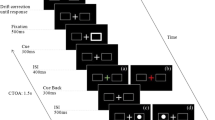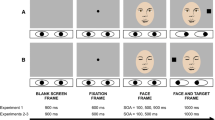Abstract.
The latency of 'reflexive' saccades (made in response to peripheral visual stimuli) was compared to that of 'voluntary' saccades performed in anti-saccade and symbolically cued paradigms. Manipulation of visual events at fixation was carefully controlled across all conditions. Reflexive saccade latency was significantly faster than the latency of all forms of voluntary saccades. Importantly, the latency of saccades made after presentation of a symbolic cue at central fixation (voluntary arrow-cue condition) was greater than that made in the anti-saccade paradigm that requires suppression of a reflexive response. It is suggested that the increase in latency of saccades made in the voluntary arrow-cue condition may reflect differences in programming a 'When' trigger signal for saccades made in the absence of a peripheral stimulus.
Similar content being viewed by others
Author information
Authors and Affiliations
Additional information
Electronic Publication
Rights and permissions
About this article
Cite this article
Walker, R., Walker, D., Husain, M. et al. Control of voluntary and reflexive saccades. Exp Brain Res 130, 540–544 (2000). https://doi.org/10.1007/s002219900285
Received:
Accepted:
Issue Date:
DOI: https://doi.org/10.1007/s002219900285




